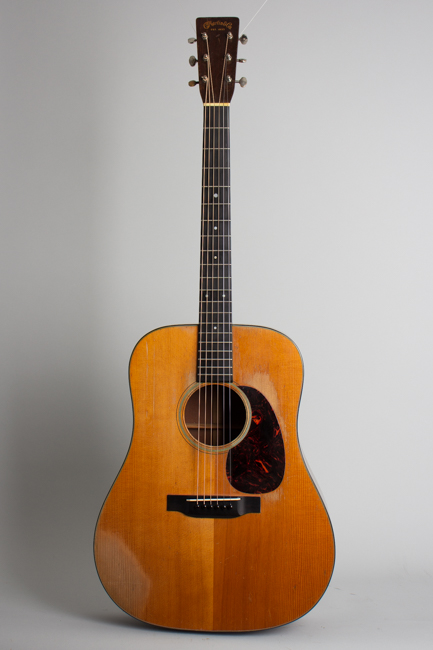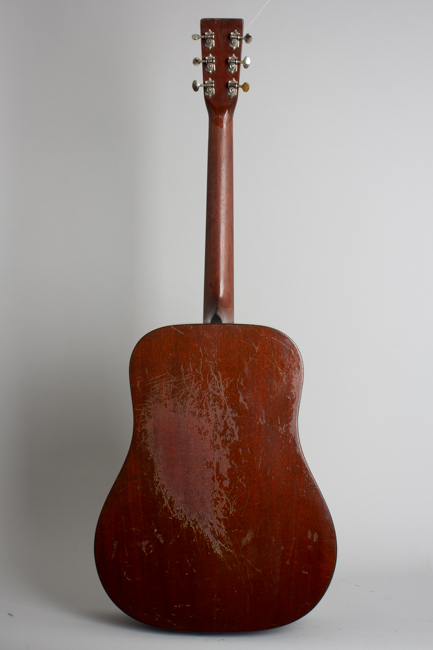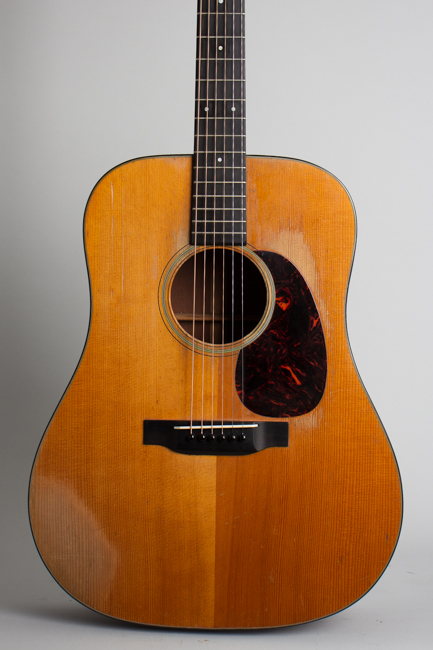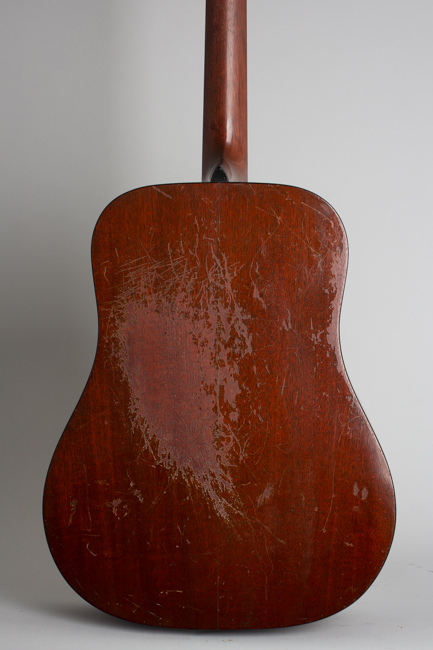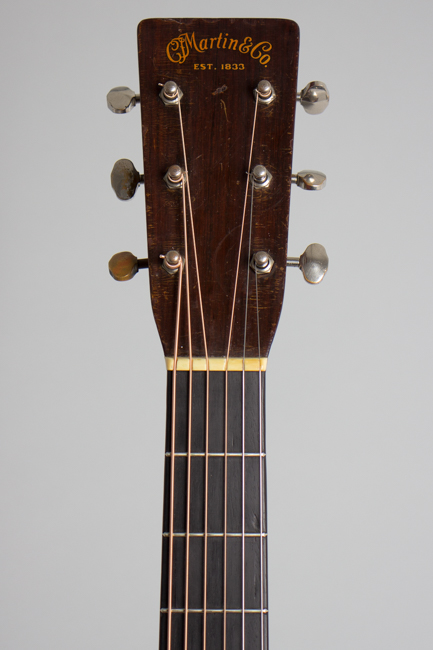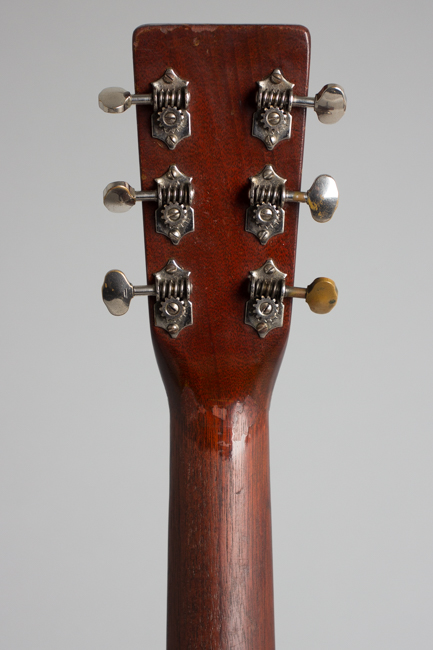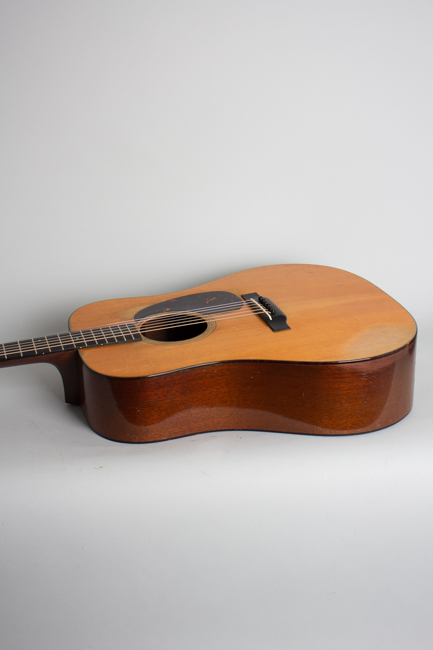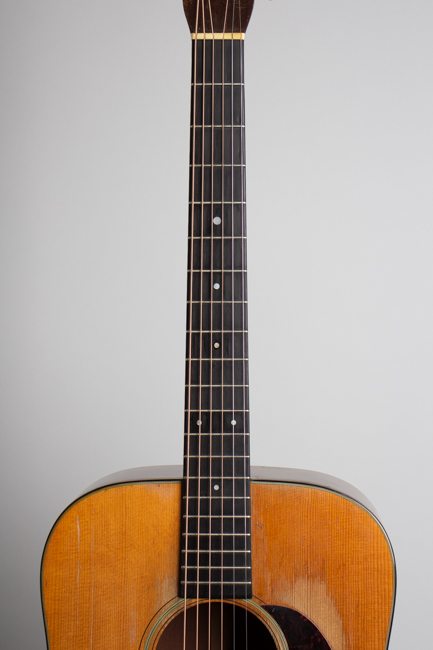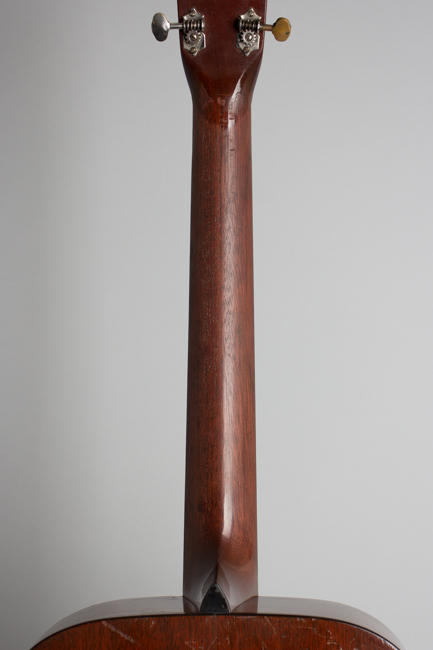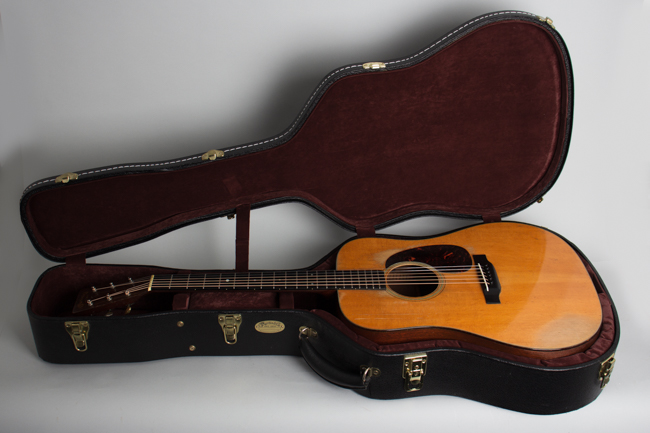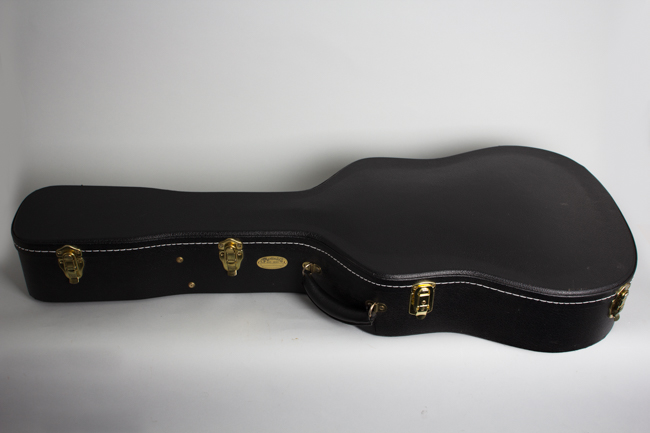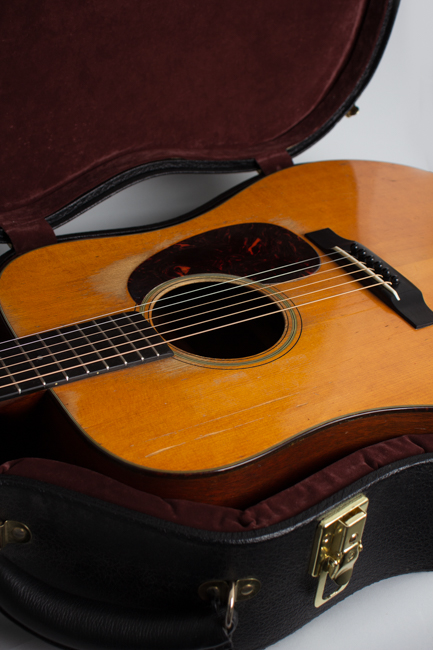C. F. Martin D-18 Flat Top Acoustic Guitar (1940)
C. F. Martin D-18 Model Flat Top Acoustic Guitar (1940), made in Nazareth, PA, serial # 75523, natural lacquer finish, mahogany back, sides and neck, spruce top, ebony fingerboard, black hard shell case.
Certain guitars have long been the standard by which all others are judged; the Pre-war Martin D-18 is always one of them. This mid-1940 example represents a beautifully played in original 14-fret mahogany Dreadnought that has seen endless imitations but very few peers since its birth. While the guitar shows quite a bit of playwear it remains in excellent playing condition and offers the expected fantastic sound in spades. The power and depth of a Dreadnought combines with the sweetness, sparkle, and singing character of the best pre-WWII mahogany Martins in a magical mix, making this an exceptionally versatile flat-top guitar suited to practically any musical situation.
This D-18 shows the classic pre-war features of the model, introduced in this form in late 1934 and widely imitated ever since. The back and sides are Honduras mahogany and the top is tight-grained Appalachian spruce, bound on the edge with tortoise celluloid. The ebony belly bridge has a canted bone saddle. The pickguard is made of tortoise celluloid in a small "teardrop" shape, a design that often proved too small to fully protect the top from the ravages of enthusiastic picking, something well displayed on this one.
The neck is mahogany with an unbound ebony fingerboard discreetly inlaid with small mixed-size pearls. The peghead is faced in Brazilian rosewood with the gold "C.F. Martin & C." decal at the top. The neck profile is round backed but with the slightest hint of a "V" profile in the way the sides bear away from the center as it moves towards the nut, which is slightly narrower than mid-thirties examples. The string spacing is 2-5/16", from low to high E, measured at the bridge. The tuners are open back individual Grover units with "butterbean" metal buttons.
While this guitar shows signs of serious use, there is less wear and repair evident than is often found considering how these instruments often got used. Playing into the open mikes of radio or barn dance stages a guitar had to have exceptional power and projection. A large percentage of Country and Western performers of this period found the Martin Dreadnought the best instrument for their situation. In 1940 the price of a new D-18 was $65 (without case), a sizable expense for many Americans at the time. They sold decently by contemporary standards, with 377 shipped that year. By the 1950s Martin was building two or three times that amount every year; pre-war examples were far scarcer even then. Today over 80 years later finding a 1940 example even as well preserved as this one is a fairly rare occurrence.
In the minds of most acoustic guitar players, collectors, and historians, very few instruments approach the pre-war Martin Dreadnought in terms of sound and historical importance. Compared to all that's come down the pike since, this is still one of the finest performing or recording guitars imaginable. While the rosewood D-28 is optimized for power and bass response, the D-18 is often a more versatile instrument combining the mellow depth of the Dreadnought with a crisp, slightly dry mahogany ring. This is a truly great early pre-war example, well played over the decades but also well-cared for and ready for many more years of service.
Overall length is 40 3/4 in. (103.5 cm.), 15 5/8 in. (39.7 cm.) wide at lower bout, and 4 7/8 in. (12.4 cm.) in depth at side, taken at the end block. Scale length is 25 1/2 in. (648 mm.). Width of nut is 1 5/8 in. (41 mm.).
While certainly not pristine this is a relatively well preserved and nicely original guitar overall. Cosmetically it shows evidence of years of serious play time. There are areas of pick wear and a number of scratches on the top, but no cracks. This wear is deepest around the edges of the pickguard and the sound hole, worn through to the wood on the treble side rosette, the bass side soundhole edge near the fingerboard extension and at the top, treble side and bottom of the pickguard. On the bass side lower bout there is a large area of finish worn through, the likely result of years of arm-wear.
There are several "case lid bites" to the top on the upper bass side and, for good measure, another on the treble sidle. Two long scratches on the bass side upper bout are adjacent to an area where a setlist (or something) was likely attached and removed, leaving tape impressions in the finish. A spot above that next to the neck block has a smaller area of wear. The original lacquer has aged and ambered nicely (mostly on the top) with some typical light checking; there has been no overspray added.
There is a quite large area of buckle rash on the back, largely on treble side and several noticeable scratches throughout, some are fairly deep. It's quite likely a cowboy belt buckle was involved! The finish on the bass side rim of the lower bout has been worn away, corresponding to the armwear on the top. The only serious repair is a repaired crunch on the treble side rim next to the tail block along with a couple of glued cracks, each about three inches on either side of the repair. This area was glued, sanded, touched up and oversprayed over about four inches long and two inches high. There are no other cracks on the guitar.
The finish on the back of the neck has been worn through from play over the years; it may have been lightly sanded, though not enough to change the contours. The neck has been neatly reset and the guitar nicely refretted with correct style wire so playability is excellent; the bone nut is original. The tuners are the correct original open-back Grovers with metal buttons. There are two filled strap button holes, one on the spine of the heel and one on the treble side of the heel. Both have been neatly filled and touched up.
The ebony bridge is a replacement carefully made to the same contours and footprint as the original. There are slight tooling marks around the bridge to indicate this work; the bone saddle is more recent as well. Internally the only alterations are four cross grain cleats added to support the repair near the heel block and a careful filling of the bridge pin holes of the original bridge plate with a mix of sawdust and glue to ensure that the strings fit snugly. Also, there is the stamp of a previous owner and their location next to the center strip.
Despite (or probably because of) this litany of wear this D-18 is a truly excellent playing example, set up with a good flatpicking action and plenty of room to lower the saddle if a mellower fingerpicker's approach is desired. In any playing situation the sound of these lightly built pre-war Dreadnoughts is truly inspiring, and this one certainly does not disappoint. An extremely fine player's D-18, this guitar has been used but not abused remaining more original than many for over 80+ years now. With some care it will still be providing wonderful sounds for many decades to come. Overall Very Good + Condition.
Certain guitars have long been the standard by which all others are judged; the Pre-war Martin D-18 is always one of them. This mid-1940 example represents a beautifully played in original 14-fret mahogany Dreadnought that has seen endless imitations but very few peers since its birth. While the guitar shows quite a bit of playwear it remains in excellent playing condition and offers the expected fantastic sound in spades. The power and depth of a Dreadnought combines with the sweetness, sparkle, and singing character of the best pre-WWII mahogany Martins in a magical mix, making this an exceptionally versatile flat-top guitar suited to practically any musical situation.
This D-18 shows the classic pre-war features of the model, introduced in this form in late 1934 and widely imitated ever since. The back and sides are Honduras mahogany and the top is tight-grained Appalachian spruce, bound on the edge with tortoise celluloid. The ebony belly bridge has a canted bone saddle. The pickguard is made of tortoise celluloid in a small "teardrop" shape, a design that often proved too small to fully protect the top from the ravages of enthusiastic picking, something well displayed on this one.
The neck is mahogany with an unbound ebony fingerboard discreetly inlaid with small mixed-size pearls. The peghead is faced in Brazilian rosewood with the gold "C.F. Martin & C." decal at the top. The neck profile is round backed but with the slightest hint of a "V" profile in the way the sides bear away from the center as it moves towards the nut, which is slightly narrower than mid-thirties examples. The string spacing is 2-5/16", from low to high E, measured at the bridge. The tuners are open back individual Grover units with "butterbean" metal buttons.
While this guitar shows signs of serious use, there is less wear and repair evident than is often found considering how these instruments often got used. Playing into the open mikes of radio or barn dance stages a guitar had to have exceptional power and projection. A large percentage of Country and Western performers of this period found the Martin Dreadnought the best instrument for their situation. In 1940 the price of a new D-18 was $65 (without case), a sizable expense for many Americans at the time. They sold decently by contemporary standards, with 377 shipped that year. By the 1950s Martin was building two or three times that amount every year; pre-war examples were far scarcer even then. Today over 80 years later finding a 1940 example even as well preserved as this one is a fairly rare occurrence.
In the minds of most acoustic guitar players, collectors, and historians, very few instruments approach the pre-war Martin Dreadnought in terms of sound and historical importance. Compared to all that's come down the pike since, this is still one of the finest performing or recording guitars imaginable. While the rosewood D-28 is optimized for power and bass response, the D-18 is often a more versatile instrument combining the mellow depth of the Dreadnought with a crisp, slightly dry mahogany ring. This is a truly great early pre-war example, well played over the decades but also well-cared for and ready for many more years of service.
Overall length is 40 3/4 in. (103.5 cm.), 15 5/8 in. (39.7 cm.) wide at lower bout, and 4 7/8 in. (12.4 cm.) in depth at side, taken at the end block. Scale length is 25 1/2 in. (648 mm.). Width of nut is 1 5/8 in. (41 mm.).
While certainly not pristine this is a relatively well preserved and nicely original guitar overall. Cosmetically it shows evidence of years of serious play time. There are areas of pick wear and a number of scratches on the top, but no cracks. This wear is deepest around the edges of the pickguard and the sound hole, worn through to the wood on the treble side rosette, the bass side soundhole edge near the fingerboard extension and at the top, treble side and bottom of the pickguard. On the bass side lower bout there is a large area of finish worn through, the likely result of years of arm-wear.
There are several "case lid bites" to the top on the upper bass side and, for good measure, another on the treble sidle. Two long scratches on the bass side upper bout are adjacent to an area where a setlist (or something) was likely attached and removed, leaving tape impressions in the finish. A spot above that next to the neck block has a smaller area of wear. The original lacquer has aged and ambered nicely (mostly on the top) with some typical light checking; there has been no overspray added.
There is a quite large area of buckle rash on the back, largely on treble side and several noticeable scratches throughout, some are fairly deep. It's quite likely a cowboy belt buckle was involved! The finish on the bass side rim of the lower bout has been worn away, corresponding to the armwear on the top. The only serious repair is a repaired crunch on the treble side rim next to the tail block along with a couple of glued cracks, each about three inches on either side of the repair. This area was glued, sanded, touched up and oversprayed over about four inches long and two inches high. There are no other cracks on the guitar.
The finish on the back of the neck has been worn through from play over the years; it may have been lightly sanded, though not enough to change the contours. The neck has been neatly reset and the guitar nicely refretted with correct style wire so playability is excellent; the bone nut is original. The tuners are the correct original open-back Grovers with metal buttons. There are two filled strap button holes, one on the spine of the heel and one on the treble side of the heel. Both have been neatly filled and touched up.
The ebony bridge is a replacement carefully made to the same contours and footprint as the original. There are slight tooling marks around the bridge to indicate this work; the bone saddle is more recent as well. Internally the only alterations are four cross grain cleats added to support the repair near the heel block and a careful filling of the bridge pin holes of the original bridge plate with a mix of sawdust and glue to ensure that the strings fit snugly. Also, there is the stamp of a previous owner and their location next to the center strip.
Despite (or probably because of) this litany of wear this D-18 is a truly excellent playing example, set up with a good flatpicking action and plenty of room to lower the saddle if a mellower fingerpicker's approach is desired. In any playing situation the sound of these lightly built pre-war Dreadnoughts is truly inspiring, and this one certainly does not disappoint. An extremely fine player's D-18, this guitar has been used but not abused remaining more original than many for over 80+ years now. With some care it will still be providing wonderful sounds for many decades to come. Overall Very Good + Condition.
